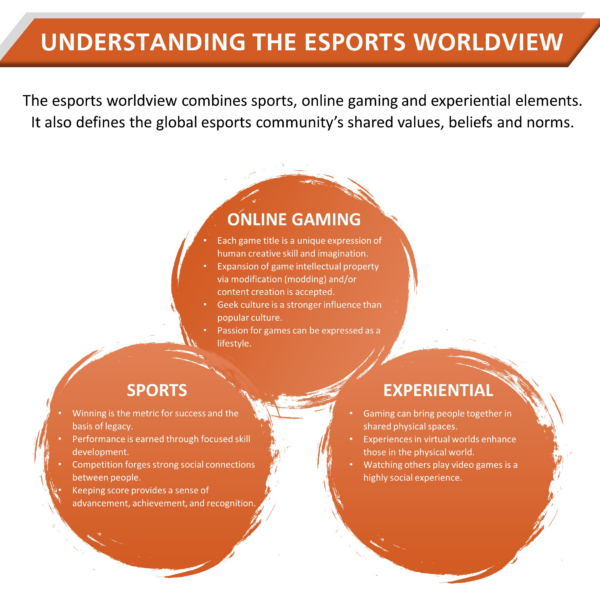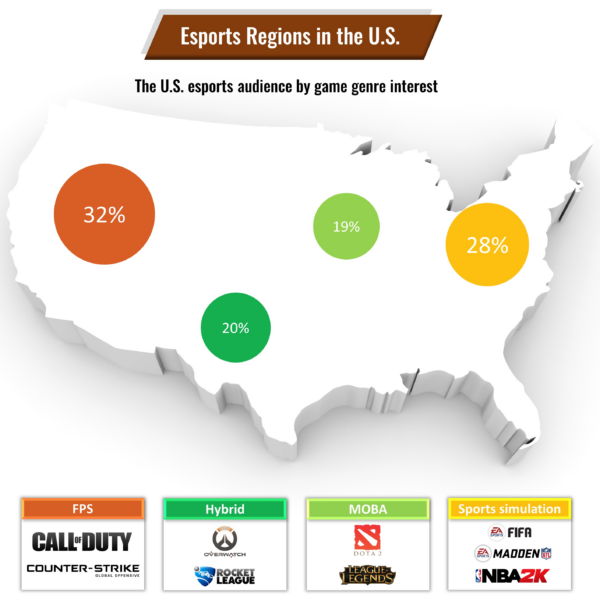This is part two of a three part series. Click here to download the entire guide (PDF).
Story-driven marketing authentically weaves your brand into the world of online gaming by tapping into the esports worldview – a specific set of beliefs, biases, and values. This worldview represents a shared culture across, what is commonly termed, the esports community. Marketing stories framed within this worldview build trust and authenticity for your brand.

Along the same lines, conflict between an audience’s worldview and your brand’s values is a non-starter. This dynamic is illustrated by the Neom partnership with Riot Games, publisher of League of Legends – the world’s top esport title.
In July 2020, Neom – a Saudi-Arabian project with designs to build a futuristic city for roughly $500 million – signed on as sponsor of Riot’s European League of Legends esports circuit (LEC). The Saudi government, which has made its stance on LGBTQ rights clear by outlawing homosexuality, is funding the bulk of Neom’s price tag.
At the time of the partnership announcement, the LEC was, among other actions, displaying a rainbow-colored logo on social media in support of Pride Week. A clear sign that the sponsor value misalignment flew under Riot’s radar.
However, the League of Legends esports community did not miss the connection. Several pro players, broadcast personalities and a multitude of fans immediately criticized the deal – on grounds that the Arabian Peninsula country upholds values that directly contradict their own. The backlash was swift and decisive enough for Riot to cancel the partnership.
While Neom’s brand values did not overtly clash with the LEC’s stance on inclusiveness and diversity, the cultural values of its host country contradicted that of LEC fans. Although, some fans opposed the sponsorship cancellation since other cultural differences can and do affect the esports worldview.
Ultimately, the global esports community spans multiple game titles, game genres and audience demographics. Stories are the ideal communication vehicle for framing your message within this incredibly unique worldview. A well-told marketing story ensures your brand is perceived as authentic and meaningful to esports consumers across the world.
Want to read the entire guide? Click here to download (PDF).
The recipe for a great story
Yesteryear’s tales spanned the length of time someone could sit in one place and listen. Today’s oversaturated media world leaves marketers in fierce competition for the average person’s attention span. Fortunately, storytelling is ideal for capturing and holding attention before something else does.
Marketing stories are purpose-driven narratives designed to:
- Keep the audience engaged.
- Humanize brand values.
- Stimulate imagination and passion.
- Stick in memory.
- Transfer emotion into a call-to-action.
When executed correctly, these stories clearly establish your brand’s core values and offer an emotional experience tied to them. According to Storynomics: Story-Driven Marketing in the Post-Advertising World by Robert McKee, doing so requires the following elements.
Story setting
The world (fictional or actual) in which a story takes place; defines the social and physical backdrop for its characters. The setting also defines the limits of possibility. For example, an 18th century setting would not include mobile phones – unless fantasy elements otherwise intervene.
The option of choosing video game settings expands the palette of options significantly. These virtual, timeless worlds are set apart from the temporal reality that you might normally choose for purpose-driven stories. Plus, game-like settings are immediately recognizable and familiar to esports audiences.
Protagonist
The lead character(s) in a story. Marketing campaigns are designed to promote the unique nature of a company’s brand. As a result, choice of protagonist in marketing stories should highlight that unique identity.
As gamers, esports audiences are accustomed to in-game experiences that cast them as protagonists in the middle of complex storylines. Therefore, esports marketing stories must feature protagonists with whom audiences can identify.
Inciting incident
An inciting incident is a meaningful event that changes the story’s positive/negative value charge. For example, a protagonist’s longtime friend might unexpectedly turn against her (loyalty turns to betrayal). Regardless of the value charge change, i.e. from positive to negative or vice versa, the incident is a pivotal moment that draws in the audience emotionally.
The reversal in fortune poses an unanswered question of, “How will this turn out?” Audiences are encouraged to join the protagonist(s) on a journey to find the answer. By doing so, it deepens an emotional investment in seeing the story through to its end.
Object of desire
The protagonist’s central goal or aim takes shape as an object of desire. The object need not be a physical item. In fact, it can range from an emotional state (happiness) to a situation (togetherness with another person) to a geographic location (endpoint in a journey). Desire to reach this goal is what drives the central character(s) forward.
Purpose-told marketing stories feature an object that reflects your brand’s values, regardless of being explicitly related to a product or service. Fortunately, there are a multitude of readymade object of desires that tie into the esports worldview.
Action/Reaction
The protagonist’s core identity determines which tactics are used to reach an object of desire. That action is associated with what the character expects to happen. The following reaction involves a gap between expectation and reality.
Powerful storytelling depends on conflict between action and reaction. The conflicting tension should mirror a real-life struggle that is relevant to the audience; thereby holding attention and deepening empathetic connection to the protagonist(s).
Crisis of choice
A story’s surprise gap between expectation and the storyworld’s reaction sets a path to the object of desire. The protagonist, seeing as much, makes a choice to take it. The audience is then led to the story’s dramatic conclusion.
Climatic reaction (conclusion)
The crisis of choice fuels a decisive action that realizes the object of desire. This relieves anticipation to find out how the story ends. The sudden moment of clarity allows your message to lodge itself in memory.
The climatic event’s emotional impact secures a place in the audience’s heart, which wins share of mind for your brand. The audience, identifying with the protagonist’s triumph, can relive the story by following the story’s call to action – e.g. purchasing a product.
Want to read the entire guide? Click here to download (PDF).
Creating story success
Structure is the foundation of storytelling’s role as a universal language. While including additional protagonists or adding multiple inciting events is perfectly acceptable, the previously mentioned elements cannot be removed, or the narrative will cease to be a story. The psychology behind this is simple: People instinctively look for certain tell-tale signs in a story experience.
Before unleashing this powerful communication format to reach esports audiences, you must design the story. Why? Because storytelling is an art. One that requires creativity, vision, and skill. Fortunately, you can also practice it the same way that painters follow a creative process to perfect their art over time.

The following process is the starting point for creating great esports marketing stories. The steps, listed below, conceptualize what will become a finished story. Specific details are added in later stages of story creation.
Step 1: Target emotion
Regardless of the related product or service category, marketing stories fill a core human need to experience emotion. So, even if you’re offering a solution to a specific consumer need, the message should be wrapped in emotional tones. In essence, the narrative should capture how you want consumers to feel about your brand.
This can be a challenge since esports attracts younger age groups than the general population, so brand awareness and perception can fluctuate. Regardless, if there is a gap between how they typically feel and how you want them to feel, the story must decidedly move them in the right emotional direction.
Step 2: Outline topics
The unique nature of online gaming means you must clearly outline topics that are acceptable and unacceptable. These boundaries are driven by your brand guidelines. To illustrate, Counter-Strike: Global Offensive (CSGO) is a popular esports title that features gameplay with violent scenarios. If that type of content is off-limits, you should avoid related topics.
Keep in mind that story topics must resonate with your brand message and the esports worldview. If you are not yet comfortable navigating the nuances of geek culture, themes based on the similarity between physical and digital sport are a good place to start, such as: coach/player relationships, a dramatic finish to a contest, perseverance leading to success.
Step 3: Define brand integration
Emotionally driven narratives require one or more characters with whom the audience empathizes. Since your brand plays a central role in the storyline, it must seamlessly fit into the character-driven backdrop. This is accomplished by either placing your brand into the plot as-is or personification – creating a character who represents the brand identity.

Personification is impactful because it is much easier for audiences to connect with a personality than an inanimate product or service. It is also an opportunity to establish unique relationships with consumers. Progressive Insurance’s Flo is a great example of brand personification put to work in storytelling.
Step 4: Understand the audience
The best way to understand someone is to listen. So, eSports iQ was developed to transform large volumes of publicly available social media data into analytics on competitive video game audiences. eSports iQ is a software platform that uses IBM Watson artificial intelligence (AI) to help you understand esports audiences. It discovers dimensions that are missed by traditional surveys and/or manual research.
eSports iQ’s segmentation technology identifies audience personas, which you can use to customize your storytelling campaign(s). For instance, personas include psychographic insights into audience needs and wants – to which your story should appeal. This data-driven approach helps you reach specific sections of the overall esports audience in a simple, cost-effective manner.
Step 5: Clarify the market
Competitive video games offer the opportunity to reach a global audience of young, digitally savvy consumers. However, campaign goals are always driven by business objectives. So, it is important to connect with audiences in your target market(s). Especially, if your products are location-specific or are only available in certain regions.

Clarifying these details upfront, keeps you from wasting time and money marketing to consumers who are not likely to become customers. Esports audience nuances in specific markets help focus story design. Case in point, game title popularity varies based on audience location. Taking these facts into account helps you craft stories that build relationships with your ideal customer.
Want to read the entire guide? Click here to download (PDF).
